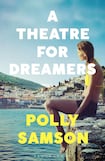
In September 1960, at the age of 26, Leonard Cohen bought a white-washed house on the notorious Greek island of Hydra – the idyll he would return to repeatedly in the ensuing decade for what he described as “sitting-down time”. Now a more exclusive resort, the Hydra of the 1960s was a bohemian paradise where artists, writers and musicians flocked for a heady mix of tranquillity, debauchery and inspiration.
This is the era that Polly Samson aims to capture with her fourth novel. Already accomplished as a journalist and song-writer – Samson has co-written many songs with her husband David Gilmour – A Theatre for Dreamers feels like the book the author was born to create.
Readers will be allured by the promise of a young Canadian poet cavorting among a dazzling cohort of famous friends and lovers, but, in truth, the story told is not Cohen’s. His appearances are glorious vignettes of a manwho is not yet famous, in a blue raincoat , and the author’s depth of appreciation for him is vivid, but Samson resists in lingering the spotlight on him for too long.
Rather, this is a coming-of-age story. Erica, a searching, naive but ultimately beguiling 18-year-old, offers us the lens through which this decadent summer of 1960 is viewed, and perhaps the book is the better for it. So much non-fiction has already been written about those halcyon days that this gives Samson a fresh perspective.
Erica and her brother Bobby flee to Hydra, in the wake of their mother’s death, to escape a bleak existence in their abusive family home in England. Inspired by a novel written by their mother’s old friend, the Australian writer Charmian Clift, they arrive on the island innocent, but ripe for adventure. Of the many “real-life” inhabitants of the island that we meet, Clift is the most intimately drawn and around whom the narrative of Samson’s novel orbits.
We are introduced to the cast of characters on the island alongside Erica, hear the gossip through her ears, but only witness what she herself sees. As the young ingenue and relative outsider, this results, at times, in the feeling that much of the action is happening off-screen without the reader truly experiencing it.
Erica, something of a “buzzing mosquito” in their midst, observes the collapse of the dysfunctional marriage between the renowned Norwegian writer Axel Jensen and an exquisitely drawn Marianne Ihlen – the woman destined to become the mesmerising muse of Cohen – but what we hear from the subjects directly is limited. What might perhaps be lost with Erica’s limited access to the interiority of her associates, however, is gained by the holistic view her character offers us of the social and cultural politics tangled up in the supposedly free-spirited hedonism of the time.
This novel is something of a Trojan horse. Yes, it offers an enticing insight into the bohemian glamour of the infamous Hydra, which attracted the likes of Henry Fonda and Princess Margaret; yes, we are indulged with irresistible moments of greatness from Cohen, such as when he shyly admits to only writing poetry in order to woo women, that he believed that was what men had to do. But the book is really about is the great debate of who is allowed to create. Greatest of all, it challenges and undermines the very problematic notion of the muse.
The book is set in 1960 but women are still struggling with the miserable 1950s expectations of what their lives could be. Even amongst the liberal, artistic community of Hydra, there lingers a heavy obligation that the men’s work comes first. Clift is the discordant voice in the novel that hopes to inspire Erica to claim something more for herself, thrusting Simone de Beauvoir’s The Second Sex upon her, and urging her not to “let the buggers clip her wings just as she is learning to fly”.
Clift, who has sacrificed her own writing to support her husband George Johnston’s work, scorns Jensen for his lack of awareness that “his star was only hanging that high because Ihlen had put it there, creating a perfect universe for him to write”. Erica recalls Ihlen remarking how difficult it was for a girl to know the difference between love and service. Clift hopes that Erica’s generation might make “a better fist of fighting the status quo”, and supposes she should be thankful for what progress has been made.
What A Theatre for Dreamers illuminates so poignantly is that 60 years later, a lot has been done, but there is still so much more to do before both men and women can make that distinction between love and service, and have equal access to a perfect universe in which they can create.












